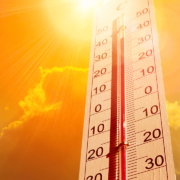A record rise in temperatures is expected in the next 5 years
In five years, temperatures are expected to reach 1.5 degrees more than normal. Scientists predict that it will be a “sad” day, as there is no going back. However, they encourage to continue reducing the emission of greenhouse gases as much as possible.
The World Meteorological Organization (WMO) warns that global temperatures are likely to reach record levels in the next five years, with temperatures reaching more than 1.5 degrees Celsius above pre-industrial levels for at least one year.
“We estimate that in the next five years we will reach 1.15 degrees Celsius temporarily, but in the next 15 to 20 years, we estimate that this could be the most permanent feature of the climate,” said Petteri Taalas, WMO Secretary General.
“Actually, there is no going back to the old days because we already have a very high concentration of carbon dioxide and also, of course, we have increased the concentration of methane in the atmosphere.”
CO2, methane and other greenhouse gases that cause global warming are the main drivers of climate change. Although many greenhouse gases occur naturally, human activities increase their concentration in the atmosphere.
Talaas explained that the negative trend is likely to continue until the 2060s and then “the return to the normal level could take even thousands of years because we already have such a high concentration of carbon dioxide” in the atmosphere.
Meteorologists expect the most dramatic changes to occur in the Arctic, where warming is disproportionately high and temperatures in this region are projected to be more than three times the global average in the next five years.
Talaas warns that it will have a major effect on the ecosystem. “For example, we expect there will be changes in fisheries and melting of permafrost and it will also have a big impact on infrastructure.”
He pointed out that many settlements are built on permafrost: “railways, roads, gas pipelines, etc., and they will be in danger because of this high level of warming.”
The world organization’s report predicts that precipitation patterns over the next five years will result in increased rainfall in the Sahel, northern Europe, Alaska and northern Siberia and reduced rainfall in the Amazon and parts of Australia.
Source: www.vozdeamerica.com




Leave a Reply
Want to join the discussion?Feel free to contribute!